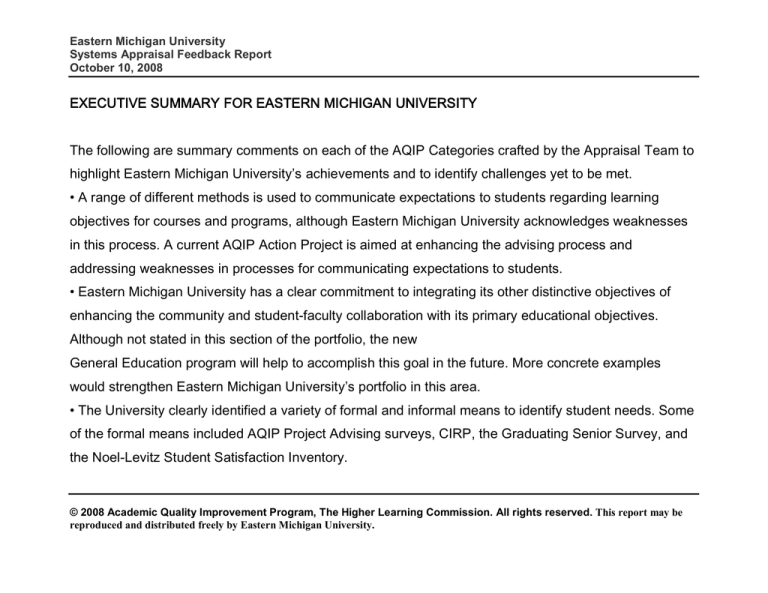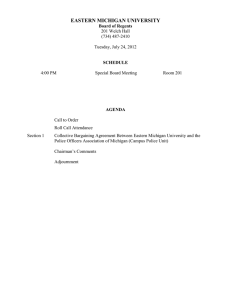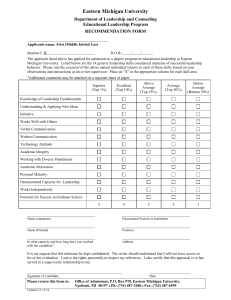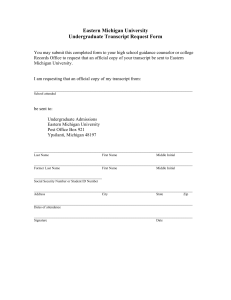
Eastern Michigan University Systems Appraisal Feedback Report October 10, 2008 EXECUTIVE SUMMARY FOR EASTERN MICHIGAN UNIVERSITY
The following are summary comments on each of the AQIP Categories crafted by the Appraisal Team to
highlight Eastern Michigan University’s achievements and to identify challenges yet to be met.
• A range of different methods is used to communicate expectations to students regarding learning
objectives for courses and programs, although Eastern Michigan University acknowledges weaknesses
in this process. A current AQIP Action Project is aimed at enhancing the advising process and
addressing weaknesses in processes for communicating expectations to students.
• Eastern Michigan University has a clear commitment to integrating its other distinctive objectives of
enhancing the community and student-faculty collaboration with its primary educational objectives.
Although not stated in this section of the portfolio, the new
General Education program will help to accomplish this goal in the future. More concrete examples
would strengthen Eastern Michigan University’s portfolio in this area.
• The University clearly identified a variety of formal and informal means to identify student needs. Some
of the formal means included AQIP Project Advising surveys, CIRP, the Graduating Senior Survey, and
the Noel-Levitz Student Satisfaction Inventory.
© 2008 Academic Quality Improvement Program, The Higher Learning Commission. All rights reserved. This report may be reproduced and distributed freely by Eastern Michigan University. Eastern Michigan University Systems Appraisal Feedback Report October 10, 2008 Examples of the informal means include feedback from the Division of Student Affairs Student
Leadership Group and academic departments.
• The University has clear processes for recruiting and orienting new employees. New faculty
participates in orientation programs at the University level prior to first semester assignment and
subsequently by college, department and union orientations. Staff and administrators also participate in
orientations collectively and at the department level. Orientations stress performance expectations, pay
and benefits and the University mission. A key focus for new faculty is to help them understand the
diversity of the student body, and to prepare them to work with those students.
• Communication processes for the University employ a wide range of methods for sharing information,
both vertically and horizontally, through publications and regularly scheduled meetings of committees
and councils. The processes are embedded in collective-bargaining agreements, but it is unclear
whether these methods effectively foster communication in upward, downward, and horizontal
directions. The University may improve its communications by insuring that information and input flows
up, as well as down, and travels across institutional areas.
• Eastern Michigan University is expanding it efforts to measure the impacts of its student and
administrative support services. At the University level, the NSSE and CIRP surveys provide feedback
© 2008 Academic Quality Improvement Program, The Higher Learning Commission. All rights reserved. This report may be reproduced and distributed freely by Eastern Michigan University. Eastern Michigan University Systems Appraisal Feedback Report October 10, 2008 and opportunities for comparison with other schools. The major areas providing support services employ
more than one measure, using both satisfaction and utilization data. As processes to regularly use these
data are implemented, the University will have better capacity to gauge the effects of its student and
administrative support systems.
• Measures of the effectiveness of the information and data systems have been identified, which may
include timeliness, usefulness, accuracy, reliability, meaningfulness and accessibility. However, it is not
clear the extent to which measurement of these criteria are utilized across all areas of the University.
Faculty and student surveys are used to elicit feedback, along with help-desk satisfaction data. It
appears that concerns remain about the quality and response rates of these systems. Eastern Michigan
University is currently waiting for the full implementation of the Balanced Scorecard in order to make
more effective judgments about the effectiveness of its information systems.
• Eastern Michigan University has recently developed and implemented a strategic planning process.
The major components of the planning process include the following: identify internal and external
factors; develop strategic planning process and assessment strategies; periodic evaluation of plan; and
standardize practices. This planning process allows the institution to establish a culture that understands
and welcomes continuous improvement principles and practices.
© 2008 Academic Quality Improvement Program, The Higher Learning Commission. All rights reserved. This report may be reproduced and distributed freely by Eastern Michigan University. Eastern Michigan University Systems Appraisal Feedback Report October 10, 2008 • The University has identified some measures by which it can assess the effectiveness of its
collaborative relationships. Information and feedback are provided from various collaborators,
particularly feeder schools and colleges, along with advisory boards. Eastern Michigan University can
strengthen its feedback sources with more systematic information gathering, particularly in key areas
such as the service learning collaborators.
© 2008 Academic Quality Improvement Program, The Higher Learning Commission. All rights reserved. This report may be reproduced and distributed freely by Eastern Michigan University.



